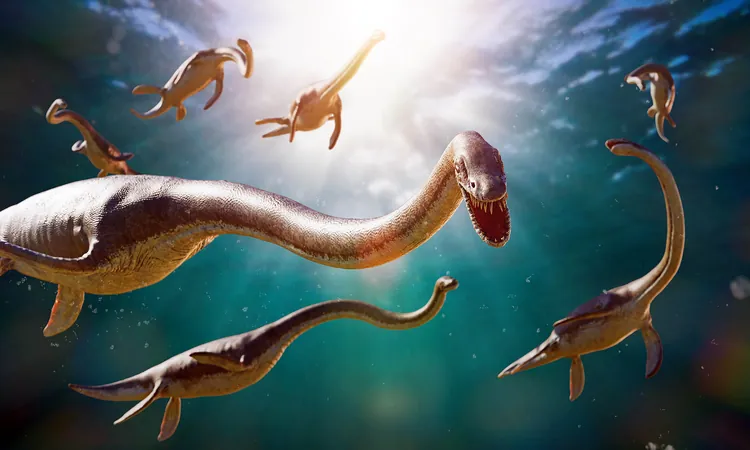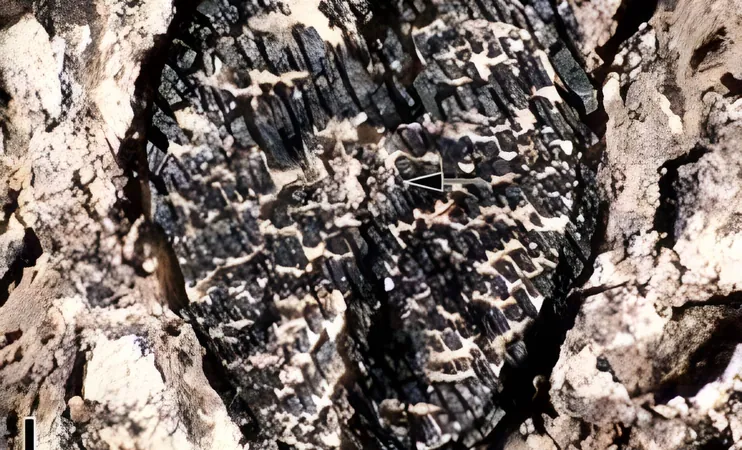
Ancient Marine Reptiles: The Apex Predators That Would Have Devoured Killer Whales!
2025-01-16
Author: Ting
The Discovery of Formidable Predators
Paleontologists have meticulously pieced together the lives of these massive reptiles and other marine life from approximately 130 million years ago—a time filled with unusual biodiversity. Their research highlights colossal reptiles that exceeded lengths of 33 feet (10 meters), which hints at a predatory lifestyle of remarkable dominance.
Intriguingly, these reptiles occupied the seventh level of a reconstructed Cretaceous food web, a staggering feat compared to the modern-day killer whales and great white sharks that rarely surpass the sixth trophic level. This vital study was spearheaded by Dirley Cortés, a doctoral candidate at McGill University's Department of Biology, alongside co-author Professor Hans Larsson.
Unraveling Ancient Food Chains
The research elaborates on how large predators typically hold dominion in oceanic food chains, often referred to as "trophic levels." While modern marine environments typically see apex predators like orcas reigning at the sixth level, findings suggest Mesozoic reptiles pushed those boundaries even further.
"This study reveals potential ecological interactions that have remained largely unexplored," Cortés explained. By analyzing fossils from the Paja Formation, the team inferred that these ancient marine reptiles not only existed but dominated the eating hierarchy, likely consuming whatever came their way.
Reconstructing the Past
The investigation involved building a detailed framework of ancient marine life by examining size, possible feeding mechanisms, and comparisons with contemporary marine species. The data revealed a complex and robust community of predators in the warm Cretaceous waters, thriving on a variety of invertebrate species that filled the lower trophic levels.
By cross-referencing modern Caribbean reef ecosystems with fossil evidence, researchers disclosed intricate links among prehistoric creatures, expanding our understanding of oceanic hierarchies.
The Evolution of Competition
Ocean food webs evolve over time, often as a response to competition among species for resources. During the Mesozoic era, intensive competition among marine predators drove the evolution of unique feeding strategies and adaptations.
Paleontologists have dubbed this period the Mesozoic Marine Revolution, marked by a significant increase in shell-crushing snails and various predatory invertebrates. This challenging environment led ancient marine reptiles to evolve into formidable hunters, resulting in massive sizes and advanced hunting techniques.
The Relevance to Today’s Ecosystems
Studying these ancient creatures is not just about uncovering fossils; it provides valuable insights into our planet's biological past. Researchers emphasize that these discoveries can help us understand ecosystem resilience against modern-day challenges like climate change and habitat loss. The fossilized networks of these ancient predators serve as a reminder of the far-reaching influence species at the top of the food chain can exert on their environments, ultimately fostering biodiversity.
A Glimpse into the Future
These findings illuminate a crucial lesson: significant shifts in ocean biodiversity occurred long before humans arrived on the scene. The extinction of these majestic marine reptiles marked the end of the Mesozoic era, but their ecological legacy is still etched in the fossil record.
The evidence from the Paja Formation offers a tantalizing suggestion that new habitats were emerging, enabling marine reptiles to achieve sizes and predatory roles largely unmatched by their modern counterparts.
Looking Ahead
Researchers express enthusiasm about the prospect of further exploration into other fossil sites. There’s potential that the Paja Formation isn't an isolated phenomenon and that vast oceans could have teemed with similarly powerful predators throughout geological history. This ongoing research indicates that over millions of years, the seas have indeed produced creatures even more formidable than those we know today.
Stay tuned for more insights and discoveries about the incredible history of our oceans!


 Brasil (PT)
Brasil (PT)
 Canada (EN)
Canada (EN)
 Chile (ES)
Chile (ES)
 Česko (CS)
Česko (CS)
 대한민국 (KO)
대한민국 (KO)
 España (ES)
España (ES)
 France (FR)
France (FR)
 Hong Kong (EN)
Hong Kong (EN)
 Italia (IT)
Italia (IT)
 日本 (JA)
日本 (JA)
 Magyarország (HU)
Magyarország (HU)
 Norge (NO)
Norge (NO)
 Polska (PL)
Polska (PL)
 Schweiz (DE)
Schweiz (DE)
 Singapore (EN)
Singapore (EN)
 Sverige (SV)
Sverige (SV)
 Suomi (FI)
Suomi (FI)
 Türkiye (TR)
Türkiye (TR)
 الإمارات العربية المتحدة (AR)
الإمارات العربية المتحدة (AR)